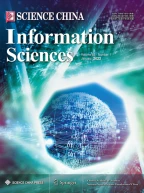Abstract
Massive amount of small data generated by machine type communications (MTC) will pose a challenge to the future fifth generation (5G) wireless network. Since the information from or to the machine type users aggregating closely are highly correlated, the relevance of data can be excavated by big data analysis to help improve the spectral efficiency. In this paper we proposed an aggregation transmission scheme (ATS) for MTC downlink transmissions in which the transmission order of users’ data packets can be adjusted according to their relevance under the delay constraints. The users having relevance will temporally share the time slots and their data are transmitted in a multicast way so that much less timeslots are needed. We propose three different algorithms, conditional random search (CRS), standard-row algorithm (SRA), and genetic algorithm (GA) to tackle the problem of transmission order adjustment. Simulation results validate the good performance of ATS and demonstrate that SRA has the lowest complexity while GA may achieve a better performance. We also analyze the impact of different delay requirements. Our work sheds light on dealing with massive MTC data traffic for future wireless communications.
Similar content being viewed by others
References
Chen K C. Machine-to-machine communications for healthcare. J Comput Inf Sci Eng, 2012, 6: 119–126
Fadlullah Z M, Fouda M M, Kato N, et al. Toward intelligent machine-to-machine communications in smart grid. IEEE Commun Mag, 2011, 49: 60–65
Wu G, Talwar S, Johnsson K, et al. M2M: from mobile to embedded Internet. IEEE Commun Mag, 2011, 49: 36–43
Cisco. Cisco Visual Networking Index: Global Mobile Data Traffic Forecast Update, 2016–2021. White Paper. 2017
Ericsson L. More than 50 billion connected devices. White Paper. 2011
Dawy Z, Saad W, Ghosh A, et al. Toward massive machine type cellular communications. IEEE Wirel Commun, 2017, 24: 120–128
Shariatmadari H, Ratasuk R, Iraji S, et al. Machine-type communications: current status and future perspectives toward 5G systems. IEEE Commun Mag, 2015, 53: 10–17
Ma Z, Zhang Z Q, Ding Z G, et al. Key techniques for 5G wireless communications: network architecture, physical layer, and MAC layer perspectives. Sci China Inf Sci, 2015, 58: 041301
Andrews J G, Buzzi S, Choi W, et al. What will 5G be? IEEE J Sel Areas Commun, 2014, 32: 1065–1082
Chen X, Chen T Y, Guo D N. Capacity of Gaussian many-access channels. IEEE Trans Inf Theory, 2017, 63: 3516–3539
Xie R G, Yin H R, Chen X H, et al. Many access for small packets based on precoding and sparsity-aware recovery. IEEE Trans Commun, 2016, 64: 4680–4694
Zhang G P, Liu P, Yang K, et al. Orthogonal resource sharing scheme for device-to-device communication overlaying cellular networks: a cooperative relay based approach. Sci China Inf Sci, 2015, 58: 102301
Lien S Y, Chen K C, Lin Y. Toward ubiquitous massive accesses in 3GPP machine-to-machine communications. IEEE Commun Mag, 2011, 49: 66–74
Lecompte D, Gabin F. Evolved multimedia broadcast/multicast service (eMBMS) in LTE-advanced: overview and Rel-11 enhancements. IEEE Commun Mag, 2012, 50: 68–74
Valerio D, Ricciato F, Belanovic P, et al. UMTS on the road: Broadcasting intelligent road safety information via MBMS. In: Proceedings of the 2008 IEEE 67th Vehicular Technology Conference (VTC-Spring), Singapore, 2008. 3026–3030
Chin W H, Fan Z, Haines R. Emerging technologies and research challenges for 5G wireless networks. IEEE Wirel Commun, 2014, 21: 106–112
Lu X, Wetter E, Bharti N, et al. Approaching the limit of predictability in human mobility. Sci Rep, 2013, 3: 1–9
Song C M, Qu Z H, Blumm N, et al. Limits of predictability in human mobility. Science, 2010, 327: 1018–1021
Hung H N, Lin Y B, Lu M K, et al. A statistic approach for deriving the short message transmission delay distributions. IEEE Trans Wirel Commun, 2004, 3: 2345–2352
Beasley D, Bull D R, Martin R R. An overview of genetic algorithms: part 1, fundamentals. Univ Comput, 1993, 15: 56–69
Sun Y H, Zhang S H, Zhu J K, et al. Aggregation postpone transmission scheme for machine type communications. In: Proceedings of the 2016 IEEE 19th Wireless Personal Multimedia Communications (WPMC), Shenzhen, 2016. 205–210
Acknowledgements
This work was partially supported by Natural Science Foundation of China (Grant No. 61461136002), Key Program of National Natural Science Foundation of China (Grant No. 61631018), Fundamental Research Funds for the Central Universities, and Huawei Innovation Research Program.
Author information
Authors and Affiliations
Corresponding author
Additional information
Conflict of interest The authors declare that they have no conflict of interest.
Rights and permissions
About this article
Cite this article
Sun, Y., Zhao, M., Zhang, S. et al. Aggregation transmission scheme for machine type communications. Sci. China Inf. Sci. 60, 100305 (2017). https://doi.org/10.1007/s11432-017-9196-0
Received:
Accepted:
Published:
DOI: https://doi.org/10.1007/s11432-017-9196-0
